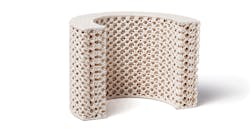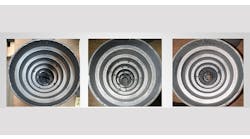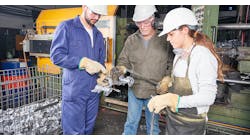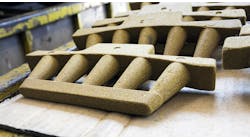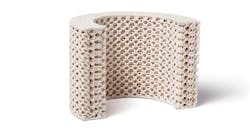Q: Our sand hopper always has built-up sand, which diminishes its effectiveness. Is there a solution to address this?
A: Sand hoppers are stationary units for holding and delivering prepared sand mixtures, for making molds and cores. It’s a simple process but one that is in steady use, and keeping the hopper clean and functioning – so that it delivers the required volume of sand on-demand – can be time-consuming and expensive. Anyone who works in a foundry and/or core shop that uses sand hoppers has wondered: What is the most efficient way to clean and maintain the system?
The issues that operators face when cleaning sand hoppers on core machines, regardless of the process or sand hoppers under sand mixers involved, are going to be similar. First, the operators will likely need to stop core and/or mold production early to begin the clean-up process, which of course leads to down-time.
Then, the operators will need to hammer or air-chisel the sand hopper to remove the sand that has built-up over time. It is important to note here that safety is always a concern for operators cleaning sand hoppers due, to the confined space and instruments needed for the job. If cleaning is not done properly and on a regular basis the sand will continue to build up and the system’s effectiveness will diminish – prolonging the time needed for future cleaning.
For this reason, many foundries simply accept sand-hopper cleaning as a sunk cost in their process. Recently ASK Chemicals developed a simple and ingenious solution developed called “ISOSOCK™” that effectively and affordably deals with this issue.ISOSOCK is essentially a custom-fitted liner to cover interior sides of the sand hopper, providing many benefits to the operator and machine. First and foremost, it addresses operator safety. When using an ISOSOCK workers will not need to use air tools or hammers to clean any built-up sand.
For the plant operator this is important also because it reduces the release of airborne silica particles that may be inhaled during the clean-up process.
In addition, the new solution eliminates the necessity to work in awkward positions to remove the built-up sand. Because of the ease of cleanup using an ISOSOCK, downtime may be reduced significantly – leading to more production uptime. Because the prepared sand does not stick to the ISOSOCK sand, the volume of debris that must be disposed after hopper cleanup is greatly reduced as well.
Additional benefits to the ISOSOCK are improved sand bench life and humidity resistance. This is a result of less sand being exposed to ambient air, which would impact the performance mixed sand. For foundries working with the cold-box process this would include less exposure to fugitive amines or SO2 from the curing process, contributing to better mold and core quality.
ISOSOCKS will require minimal cleaning – which can be done with a soft brush. Air tools that might tear the fabric are not recommended for cleaning the ISOSOCK.
Join the Conversation. Email Your Questions for ASK Chemicals
